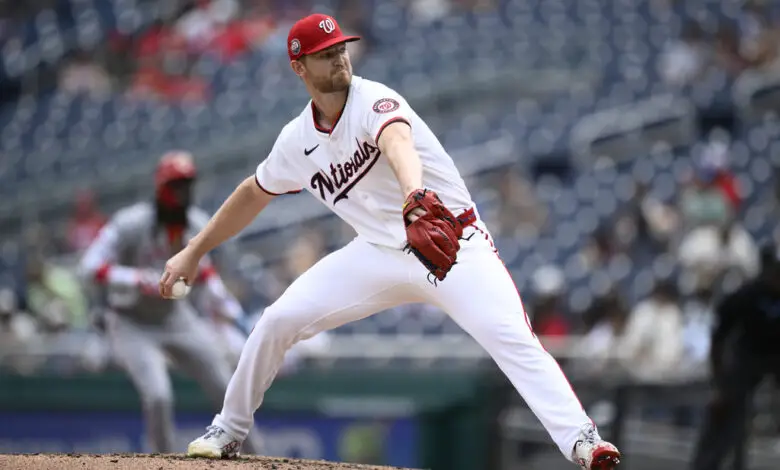
Cubs’ Initial Pitching Trades Look Like Precursors to Bigger Deal(s)
What do you do when you DFA one former White Sox reclamation project earlier in the day? Why, you trade for another one. Not long after removing Chris Flexen from the roster to make room for Moises Ballesteros, the Cubs acquired Michael Soroka from the Nationals in exchange for 18-year-old rookie-ball shortstop Ronny Cruz (No. 13 in system) and Triple-A outfielder Christian Franklin (No. 14). That seems like a steep price for a rental starter with a 4.87 ERA, huh?
Not long after that deal was announced, the Cubs picked up 35-year-old righty reliever Andrew Kittredge from the Orioles in exchange for low-level shortstop Wilfri De La Cruz (No. 20). Regardless of what they gave up, it’s another underwhelming move on the surface. Kittredge has missed a lot of time due to injury over the past few years, with Tommy John surgery in 2022 standing out as the most significant issue. But he made 74 appearances for the Cardinals last season and is fully healthy at this point.
While neither of these moves looks to be the kind meant to yield a significant lift to the club, both provide the staff with veteran depth and set up the likelihood of bigger trades to come. The Cubs may also be banking heavily on the upside due to changes in scenery or tweaks to the pitchers’ respective repertoires, as both have subpar fastballs with the ability to spin the ball well.
Soroka’s peripherals indicate strong potential for improvement, with his 3.32 expected ERA and .218 xBA pairing nicely with the ability to miss barrels while working in the zone. His sweeping slurve sees nearly equal usage against batters on both sides of the plate and he served as a swingman for the Sox last season, a role he is likely to resume once Jameson Taillon returns or the Cubs add another starter. The sharp drop in his fastball velocity from 94-95 mph early in the season to around 91 mph lately is concerning, so perhaps shorter outings will solve the issue.
Kittredge likewise has a very underwhelming fastball, but he pitches backwards by throwing his 89 mph slider around 52% of the time. It’s been an excellent pitch that contributes heavily to a 41.7% chase rate that would be the best in MLB if he’d pitched enough to qualify. He avoids barrels and dominates right-handed hitters, plus he’s got a $9 million option for next year that the Cubs could very well exercise to help solidify the bullpen beyond this season.
Interestingly enough, both pitchers are earning $9 million this year, of which the Cubs will pay a prorated portion that comes to just under $2.9 million. That keeps plenty of powder dry on the payroll front, where they have an estimated $17 million or so left below the first tax penalty threshold. So with just a few hours left before the trade market closes, it feels like Jed Hoyer is targeting bigger impact for both the rotation and bullpen.
One possibility is former AL Cy Young winner Shane Bieber, whom the Cubs scouted at his recent Double-A rehab start as he works back from elbow reconstruction. Though they’d probably prefer a younger pitcher with more control, they’ve been high on Bieber for a while. The Pirates’ Mitch Keller remains a possibility, as do Edward Cabrera and Sandy Alcantara of the Marlins, Joe Ryan of the Twins, and MacKenzie Gore of the Nationals. The latter two are less likely and the pair of fish will take a lot to pry loose, so we’ll see.
Update: The Blue Jays are acquiring Bieber.
It also seems as though Hoyer is looking for a legit high-leverage reliever to pair with Daniel Palencia in a setup role. Kittredge is more of a Ryan Pressly surrogate who can hold down the 6th or 7th inning, and it’s possible the addition could mean the Cubs will part ways with one of their big offseason adds. After outpacing the regression monster for a while, Pressly has allowed runs in four of his last five appearances. With just 28 strikeouts in 41.1 innings, he can’t be trusted to shut the door even in low-leverage situations.
The other wrinkle here is that Eugenio Suárez heading back to Seattle means there isn’t a position player out there the Cubs will be willing to spend big to acquire. That means putting even more effort into strengthening the staff. And since they’re going to need to make room to add more pitchers, we could see multiple 40-man players moved in the deals that go down ahead of the deadline.
Fasten those seatbelts, folks, things could get really wild this afternoon.

